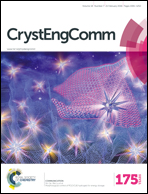Persistence of C–H⋯π(chelate ring) interactions in the crystal structures of Pd(S2COR)2. The utility of Pd(S2COR)2 as precursors for palladium sulphide materials†
Abstract
The crystallographic structures of 12 palladium xanthates, Pd(S2COR)2 (R = alkyl) show a uniform adoption of square-planar PdS4 geometries. Supramolecular aggregation in 1 (R = Me), 2 (Et) and 3 (n-Pr) is based on secondary Pd⋯S interactions, which are “turned off” when the bulk of R increases. In 4 (i-Pr), C–H⋯S hydrogen bonding is present. In each of 2–4, C–H⋯π(PdS2C) interactions are incorporated within the architecture, stabilised by Pd⋯S secondary- or C–H⋯S hydrogen-bonding. In 5–12 (R = n-Bu, i-Bu, n-Pent, i-Pent, neoPent, n-Hex, i-Hex, neoHex), varying numbers of stand-alone C–H⋯π(PdS2C) interactions involving different hydrogen donors uniformly stabilise supramolecular chains in their crystal structures. In order to determine the relative importance of the various intermolecular interactions and packing effects, a computational study using dispersion-corrected density-functional theory was performed on 3 (R = n-Pr). The results showed that the most significant contributors to the stability of the crystal structure are Pd⋯S interactions followed closely by C–H⋯π(PdS2C) interactions. Two non-specific hydrophobic interactions also contribute to the overall packing to a lesser extent. The utility of Pd(S2COR)2 to function as synthetic precursors for PdS nanoparticles and thin films was also investigated. Aerosol-assisted-CVD on representative examples generated PdS films with either matted, needle-like or granular morphologies depending on temperature and substrate. Solvothermal (ethylene glycol) decomposition generated sulphur-rich PdS nanoparticles with diameters 120 nm (7 and 10)–400 nm (8). When dodecanethiol was employed as a capping agent, PdS1.75 nanoparticles <10 nm were generated from 1.


 Please wait while we load your content...
Please wait while we load your content...